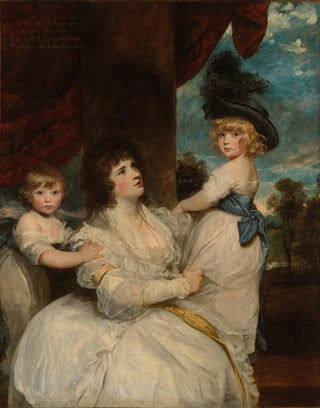Art print | Portrait of Jane, Countess of Harrington, with her sons Viscount Petersham and Honorable Lincoln Stanhope - Sir Joshua Reynolds


View from behind

Frame (optional)
Portrait of Jane, Countess of Harrington, with her sons the Viscount Petersham and the Honorable Lincoln Stanhope - Sir Joshua Reynolds – Captivating introduction
In the fascinating world of 18th-century British art, the portrait of Jane, Countess of Harrington, stands out for its ability to capture the very essence of the aristocracy of her time. This artwork, created by Sir Joshua Reynolds, a renowned portraitist of the era, evokes not only the beauty of its subject but also the affection and family bond that unite the countess with her sons. Viewing this art print transports the viewer into a world where grace and elegance blend with the depth of human relationships. Jane's serene gaze, surrounded by her children, invites reflection on the role of women in society and how they shape the future of their descendants.
Style and uniqueness of the work
Reynolds' style is recognized for its ability to combine realism and idealization, a duality that is fully present in this portrait. The technique of light and shadow, so characteristic of his work, highlights Jane's delicate features while creating an atmosphere of softness and tenderness. The composition, carefully orchestrated, directs the viewer's attention to the faces, while creating a background that suggests the richness and refinement of aristocratic surroundings. The drapery of the clothing, rendered with remarkable detail, adds a tactile dimension to the work, while the expressions of the characters reveal palpable intimacy. This portrait is not merely a static representation but a true visual story that immerses us in the intimacy of a noble family.
The artist and his influence
Sir Joshua Reynolds, an iconic figure of portraiture, left his mark on his era with his innovative vision of painting. As the first president of the Royal Academy, he played a key role in establishing artistic standards in Great Britain. His humanist approach and interest in the psychology of his subjects redefined the portrait as a genre, making it more accessible and closer to contemporary concerns. Through his works, Reynolds not only immortalized historical figures but also contributed to the creation

Matte finish

View from behind

Frame (optional)
Portrait of Jane, Countess of Harrington, with her sons the Viscount Petersham and the Honorable Lincoln Stanhope - Sir Joshua Reynolds – Captivating introduction
In the fascinating world of 18th-century British art, the portrait of Jane, Countess of Harrington, stands out for its ability to capture the very essence of the aristocracy of her time. This artwork, created by Sir Joshua Reynolds, a renowned portraitist of the era, evokes not only the beauty of its subject but also the affection and family bond that unite the countess with her sons. Viewing this art print transports the viewer into a world where grace and elegance blend with the depth of human relationships. Jane's serene gaze, surrounded by her children, invites reflection on the role of women in society and how they shape the future of their descendants.
Style and uniqueness of the work
Reynolds' style is recognized for its ability to combine realism and idealization, a duality that is fully present in this portrait. The technique of light and shadow, so characteristic of his work, highlights Jane's delicate features while creating an atmosphere of softness and tenderness. The composition, carefully orchestrated, directs the viewer's attention to the faces, while creating a background that suggests the richness and refinement of aristocratic surroundings. The drapery of the clothing, rendered with remarkable detail, adds a tactile dimension to the work, while the expressions of the characters reveal palpable intimacy. This portrait is not merely a static representation but a true visual story that immerses us in the intimacy of a noble family.
The artist and his influence
Sir Joshua Reynolds, an iconic figure of portraiture, left his mark on his era with his innovative vision of painting. As the first president of the Royal Academy, he played a key role in establishing artistic standards in Great Britain. His humanist approach and interest in the psychology of his subjects redefined the portrait as a genre, making it more accessible and closer to contemporary concerns. Through his works, Reynolds not only immortalized historical figures but also contributed to the creation






